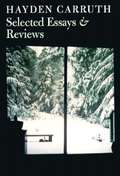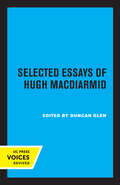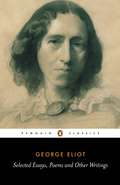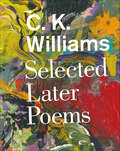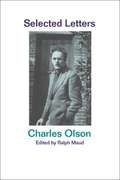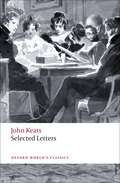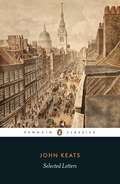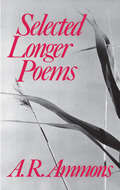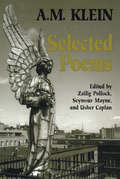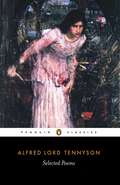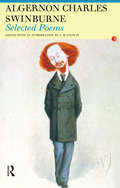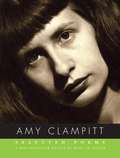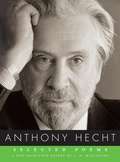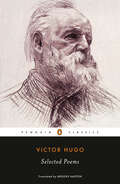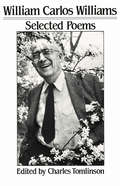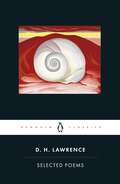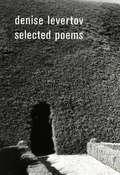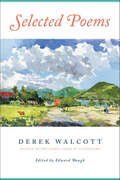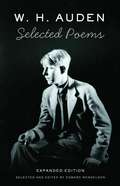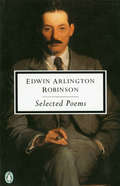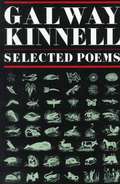- Table View
- List View
Selected Essays and Reviews
by Hayden CarruthThis book is packed with lively anecdotes of the steam era in Utah's Wasatch Range.
Selected Essays of Hugh MacDiarmid
by Hugh MacDiarmidThis title is part of UC Press's Voices Revived program, which commemorates University of California Press’s mission to seek out and cultivate the brightest minds and give them voice, reach, and impact. Drawing on a backlist dating to 1893, Voices Revived makes high-quality, peer-reviewed scholarship accessible once again using print-on-demand technology. This title was originally published in 1969.
Selected Essays, Poems and Other Writings
by George Eliot A. S. ByattThe works collected in this volume provide an illuminating introduction to George Eliot's incisive views on religion, art and science, and the nature and purpose of fiction. Essays such as 'Evangelical Teaching' show her rejecting her earlier religious beliefs, while 'Woman in France' questions conventional ideas about female virtues and marriage, and 'Notes on Form in Art' sets out theories of idealism and realism that she developed further in Middlemarch and Daniel Deronda. It also includes selections from Eliot's translations of works by Strauss and Feuerbach that challenged many ideas about Christianity; excerpts from her poems; and reviews of writers such as Wollstonecraft, Goethe and Browning. Wonderfully rich in imagery and observations, these pieces reveal the intellectual development of this most challenging and rewarding of writers.
Selected Later Poems
by C. K. WilliamsA selection from the last twenty years of C. K. Williams's career, plus new work—proof of his enduring powerC. K. Williams's long career has been a catalog of surprises, of inventions and reinventions, of honors. His one constant is a remarkable degree of flexibility, a thrilling ability to shape-shift that goes hand in hand with an essential, enduring honesty. This rare, heady mix has ensured that William's verses have remained, from book to book, as fresh and vibrant as they were when he first burst onto the scene.Selected Later Poems—a generous selection of the last two decades of Williams's poetry, capped by a gathering of new work—is a testament to that enduring vibrancy. Here are the passionate, searching, clear-eyed explorations of empathy in The Vigil; here is the candor and revelation of Repair; here is the agonizing morality of The Singing and Wait, and the unsparing reflections on aging of Writers Writing Dying; here are the poignant prose vignettes of All at Once.Williams's poetry is essential because its lyric beauty, precise and revealing images, and elegant digressions are coupled to a conscience both uneasy and unflinching. Selected Later Poems is at once a celebration of Williams's career, an affirmation of his continued position in the pantheon of American poets, and a kind of reckoning—a reminder of the ways in which art can serve both beauty and justice.
Selected Letters
by Charles OlsonIn this volume, nearly 200 letters, selected from a known 3,000, demonstrate the wide range of Olson's interests and the depth of his concern for the future which includes letters to friends and loved ones, job and grant applications, letters of recommendation, and Black Mountain College business letters, as well as correspondence illuminating Olson's poetics. The letters which span from 1931 to his death in 1970 portrays a fascinating picture of this complex poet and thinker.
Selected Letters
by John Keats Jon Mee Robert Gittings'Do you not see how necessary a World of Pains and troubles is to school an Intelligence and make it a soul?' Keats's letters have long been regarded as an extraordinary record of poetic development and soulmaking. They represent one of the most sustained reflections on the poet's art we have from any of the major English poets. Yet quite apart from the light they throw on the poetry, they are great works of literature in their own right. Written with gusto and occasionally painful candour, they show a powerful intelligence struggling to come to terms with its own mortality. Sometimes bitterly jealous in love and socially and financially insecure, at others playful and confident of his own greatness, Keats interweaves his personal plight with the history of a Britain emerging from the long years of the Napoleonic Wars into a world of political unrest, profound social change, and commercial expansion. This selection of 170 letters, written between 1816 and 1820, includes a new introduction and notes by Jon Mee explaining both the personal and political contexts that brought them to life.
Selected Letters: The Complete Poems And Selected Letters (Collins Classics Ser.)
by John Keats'I am certain of nothing but the holiness of the heart's affections, and the truth of imagination' - Keats, in a letter to his friend Benjamin Bailey in November 1817.In a period of great letter-writing, Keats's letters are outstanding. They begin in summer 1816, as he approached his twenty-first birthday, and were written over the next four years until his early death. Viewed together, they give the fullest and most poignant record we have of Keats's ambitions and hopes as a poet, his life as a literary man about town, his close relationship with his brothers and young sister, and, later, his passionate, jealous and frustrated love for Fanny Brawne.Keats enclosed many of his poems with his letters, and read together, they offer an incomparable insight into his creative process and development as a poet. This major new edition edited by Professor John Barnard includes an introduction and notes, as well as a map of Keats's Scottish walking tour and reproductions of his letters.John Keats was born in October 1795. His Poems appeared in 1817, while Endymion was published in 1818, both to mixed reviews. In 1819 he wrote The Eve of St Agnes, La Belle Dame sans Merci, the major odes, Lamia and the Fall of Hyperion. Keats was already unwell when preparing his 1820 volume for the press; by the time it appeared in July he was desperately ill. He died in Rome in 1821, in a rented apartment next to the Spanish Steps, at the age of twenty-five.John Barnard is Emeritus Professor of English Literature at the University of Leeds and has edited The Complete Poems of Keats for Penguin Classics.
Selected Longer Poems
by A. R. AmmonsReaders already familiar with Ammons’s longer mode in other books will welcome this new collection, while those familiar only with the shorter poems will find their appreciation of his work both deepened and heightened. The Selected Poems: 1951-1977 was described by one critic as “an indispensable book”; Selected Longer Poems is an indispensable companion to it. The distinguished poet A. R. Ammons once described himself as, “not so much looking for the shape as being available to any shape that may be summoning itself through me from the self not mine but ours.” This “availability” has enabled his poetic genius to be at home in forms raging from brief lyrics—the best of which he brought together in The Selected Poems: 1951-1977—all the way to poems of full book length.
Selected Poems
by Seymour Mayne A. M. Klein Zailig Pollock Usher CaplanThroughout his career A.M. Klein struggled to define for himself the role of the poet in the contemporary world. Deeply rooted in the traditions of Judaism, and at the same time powerfully attracted by the freedom and scope of international modernism, he sought to reconcile past and present, community and creative individuality. Whether or not he finally achieved his own high aims, it was, in his own words, 'something merely to entertain them.' The result was a body of work immensely rich and varied in tone, language, cultural resonance.This collection of eighty-four poems offers a representative sampling of Klein's finest poetry, while taking into account the changing critical discourse of the last fifty years. Anyone interested in experiencing the full range of Klein's poetic achievement, or in understanding the complex nature of the poet, need look no further than this eminently readable volume.
Selected Poems
by Ai QingA timeless, visionary collection of poems from one of China&’s most acclaimed poets—now available in English for the first time in a generation and featuring a foreword by his son, contemporary artist and activist Ai WeiweiOne of the most influential poets in Chinese history, Ai Qing is mostly unknown to American readers, but his work has shaped the nature of poetry in China for decades. Born between the fall of imperial Manchurian rule and the establishment of the Communist People&’s Republic, Ai Qing was at one time an intimate of Mao Zedong. He would eventually fall out with the leader and be sentenced to hard labor during the Cultural Revolution, when he was exiled to the remote part of the country known as &“Little Siberia&” with his family, including his son, Ai Weiwei. In his work, Ai Qing tells the story of a China convulsing with change, leaving behind a legacy of feudalism and imperialism but uncertain about what the future will hold. Breaking with traditional forms of Chinese poetry, Ai Qing innovatively adapted free verse, writing with a simple sincerity in clear lines that could be understood by everyday readers. Selected Poems is an extraordinary collection that traces the powerful inner life of this influential poet who crafted poems of protest, who longed for a newer, happier age, and who wrote with a profound lyricism that reaches deep into the heart of the reader.
Selected Poems
by Alfred Lord Tennyson'Tennyson', wrote T. S. Eliot, 'has the finest ear of any English poet since Milton,' and his verse remains unrivalled in its combination of verbal richness, emotional depth and intellectual engagement. Tennyson drew on classical and medieval legends in poems like 'The Lotos-Eaters' (1832) and 'The Lady of Shalott' (1832) to explore the spiritual tensions of the nineteenth century. In one of the great works of his maturity, 'In Memoriam' (1850) - written after the loss of his dearest friend - Tennyson vividly negotiated contemporary scepticism and the modern sciences of geology and evolution. Similar ground is covered in a dramatically darker mood in 'Maud' (1855), a poignant account of psychological disintegration.
Selected Poems
by Alfred TennysonAs Poet Laureate during much of Queen Victoria's reign, Alfred Lord Tennyson's spellbinding poetry epitomized the Victorian age. The works in this volume trace nearly sixty years of his literary careerand show the wide variety of poetic forms he mastered. This selection gives some of Tennyson's most famous works in full, including Maud, depicting a tragic love affair, and In Memoriam, a profound tribute to his dearest friend. Excerpts from Idylls of the King show a lifelong passion for Arthurian legend, also seen in the dream-like The Lady of Shalot and in Morte d'Arthur. Other works respond to contemporary events, such as Ode on the Death of the Duke of Wellington, written in Tennyson's official role as Poet Laureate, or the patriotic Charge of the Light Brigade, while Locksley Hall provides a Utopian vision of the future, and the late poem Crossing the Bar is a haunting meditation on his own mortality. Selected Poems is edited with an introduction and notes by Christopher Ricks. In his introduction, Ricks discusses aspects of Tennyson's life and works, his revisions of his poems, and his friendship with Arthur Hallam. This edition also includes a chronology, further reading and notes. For more than seventy years, Penguin has been the leading publisher of classic literature in the English-speaking world. With more than 1,700 titles, Penguin Classics represents a global bookshelf of the best works throughout history and across genres and disciplines. Readers trust the series to provide authoritative texts enhanced by introductions and notes by distinguished scholars and contemporary authors, as well as up-to-date translations by award-winning translators.
Selected Poems
by Algernon Charles SwinburneFirst published in 2003. Routledge is an imprint of Taylor & Francis, an informa company.
Selected Poems
by Amy Clampitt Mary Jo SalterWhen Amy Clampitt's first collection, The Kingfisher, was published, it was hailed as that rare first book that "signals a major poet in full bloom" (Los Angeles Times). Its author was sixty-three years old. Over the next eleven years, Clampitt produced four additional, major collections. Now, the most essential poems from these five volumes are gathered together.Clampitt was an impassioned observer of the natural world, the delights of which color many of these poems: writing of the fog, she described "a stuff so single / it might almost be lifted, / folded over, crawled underneath / or slid between, as nakedness- / caressingsheets." Such was the texture of her language, too. She was a traveler, reporting back from England and Greece, from California and Maine, and from her native Midwest. An Iowa transplant to New York, the descendant of pioneers, she wrote of prairies and subways; of the movements of wildflowers, people, and ideas; and of the widespread modern experience of uprootedness.Here is a treasure of Amy Clampitt's verse, for those who are reading her for the first time, as well as for those who have long admired her.From the Trade Paperback edition.
Selected Poems
by Anthony HechtAlongside Wallace Stevens, James Merrill, and other pillars of twentieth-century poetry, Anthony Hecht joins the Borzoi Poetry series.Hecht, whose writing rings with the cadences of the King James Bible, and who, as an infantryman at the end of World War II, participated in the liberation of the concentration camps, lived and experienced the best and worst of the twentieth century. Readers of this volume--the first selected poems to be made from Hecht's seven individual volumes--will be captivated by Hecht's dark music and allusions to the literature of the past. As J. D. McClatchy explains in his introduction, Hecht was a poet for whom formal elegance was inextricably bound up with the dramatic force, thematic ambition, and powerful emotions in each poem. The rules of his art, which he both honored and transformed, are "moral principles meant finally to reveal the structure of human dilemmas and sympathies."This elevated sense of what poetry can accomplish defines our experience of reading Hecht, and will ensure his place in the canon for years to come.Adam and Eve knew such perfection once,God's finger in the cloud, and on the groundNothing but springtime, nothing else at all.But in our fallen state where the blood huntsFor blood, and rises at the hunting sound,What do we know of lasting since the fall?Who has not, in the oil and heat of youth,Thought of the flourishing of the almond tree,The grasshopper, and the failing of desire,And thought his tongue might pierce the secrecyOf the six-pointed starlight, and might choirA secret-voweled, unutterable truth?--from "A Poem for Julia"From the Trade Paperback edition.
Selected Poems
by Brad Leithauser John Updike Christopher CarduffThough John Updike is widely known as one of America's greatest writers of prose, both his first book and his last were poetry collections, and in the fifty years between he published six other volumes of verse. Now, six years after his death, Christopher Carduff has selected the best from Updike's lifework in poetry: 129 witty and intimate poems that, when read together in the order of their composition, take on the quality of an unfolding verse-diary.Among these poems are precocious undergraduate efforts (including the previously unpublished "Coming into New York"), frequently anthologized midcareer classics ("Seagulls," "Seven Stanzas at Easter," "Dog's Death"), and dozens of later works in a form that Updike made his own, the blank-verse sonnet. The poems range from metaphysical epigrams and devotional poems to lyrical odes to rot, growth, and healing; from meditations on Roman portrait busts and the fleshy canvases of Lucian Freud to observations on sash cords, postage stamps, and hand tools; from several brief episodes in family history to a pair of long autobiographical poems, the antic and eclectic "Midpoint," written at age thirty-five, and the elegiac masterpiece "Endpoint," completed just before his death at seventy-six. The variety of the work is astonishing, the craftsmanship always of the highest caliber.Art, science, popular culture, foreign travel, erotic love, the beauty of the man-made and the God-given worlds--these recurring topics provided Updike ever-surprising occasions for wonder and matchless verbal invention. His Selected Poems is, as Brad Leithauser writes in his introduction, a celebration of American life in the second half of the twentieth century: "No other writer of his time captured so much of this passing pageant. And that he did so with brio and delight and nimbleness is another reason to celebrate our noble celebrant."
Selected Poems
by Victor Hugo Brooks HaxtonFor most of his life, Victor Hugo (1802-1885) was the most famous writer in the world. His legacy includes the nineteenth century's most celebrated works of drama, fiction, memoir, and criticism. But in his day Hugo was know foremost as a poet-indeed the greatest French poet of the age. He wrote with passion about history, erotic experience, familial love, philosophy, nature, social justice, art, and mysticism. In this new bicentennial edition, acclaimed poet and translator Brooks Haxton offers an exquisite selection of Hugo's finest work: love poems, historical tableaux, elegy, and idyll, including his incomparable "Boaz Asleep," which Marcel Proust praised as the most beautiful poem of the nineteenth century.
Selected Poems
by William Carlos Williams Charles TomlinsonWith the publication of this book, Charles Tomlinson's edition of Williams's Selected Poems, New Directions has introduced a gathering larger and more comprehensive than the original 1963 edition. Opening with Professor Tomlinson's superbly clear and helpful introduction this selection reflects the most up-to-date Williams scholarship. In addition to including many more pieces, Tomlinson has organized the whole in chronological order. "It isn't what he [the poet] says that counts as a work of art," Williams maintained, "it's what he makes, with such intensity of purpose that it lives with an intrinsic movement of its own to verify its authenticity."
Selected Poems
by D. H. LawrenceFrom early, rhyming works in Love Poems and Others (1913) to the ground-breaking exploration of free verse in Birds, Beasts and Flowers (1923) the poems of D. H. Lawrence challenged convention and inspired later poets.This volume includes extensive selections from these and other editions, and contains some his most famous poems, such as 'Piano', a nostalgic reflection on lost youth and love for his mother; 'Snake', exploring human fear of the natural world; the short, cutting comment on sexual politics of 'Can't Be Borne'; and the quiet philosophical resignation of 'Basta!'. Using the revised poems, but in the order in which they appeared in their original collections, this selection offers a fresh perspective that reveals an innovative poet who gave voice to his most intense emotions.
Selected Poems
by Robert Creeley Denise Levertov Paul A. LaceyDenise Levertov's Selected Poems delivers in a single accessible volume "one of the essential poets of our time" (Poetry Flash). Culled from two dozen poetry books, and drawing from six decades of her writing life, The Selected Poems of Denise Levertov offers a chronological overview of her great body of work. It is splendid and impressive to have at last a clear, unobstructed view of her ground-breaking poetry--the work of a poet who, as Kenneth Rexroth put it, "more than anyone, led the redirection of American poetry...to the mainstream of world literature." Described by Publishers Weekly as "at once as intimate as Creeley and as visionary as Duncan," Levertov was lauded as "one of the indispensable poets of our language, one of those few writers to whom it is necessary to pay attention" by The Malahat Review. No poet is more overdue for a single accessible volume; no career could be better to have within easy reach.
Selected Poems
by Derek WalcottDrawing from every stage of his career, this volume collects selected poems from Nobel Prize winner Derek Walcott's lifetime of work.Walcott's Selected Poems brings together famous pieces from his early volumes, including "A Far Cry from Africa" and "A City's Death by Fire," with passages from the celebrated Omeros and selections from his later major works, which extend his contributions to reenergizing the contemporary long poem.Here we find all of Walcott's essential themes, from grappling with the Caribbean's colonial legacy to his conflicted love of home and of Western literary tradition; from the wisdom-making pain of time and mortality to the strange wonder of love, the natural world, and what it means to be human. We see his lifelong labor at poetic crafts, his broadening of the possibilities of rhyme and meter, stanza forms, language, and metaphor.Edited and with an introduction by the Jamaican poet and critic Edward Baugh, this volume is a perfect representation of Walcott's breadth of work, spanning almost half a century.
Selected Poems
by E. E. Cummings Richard S. Kennedy"No one else has ever made avant-garde, experimental poems so attractive to both the general and the special reader."--Randall Jarrell The one hundred and fifty-six poems here, arranged in twelve sections and introduced by E. E. Cummings's biographer, Richard S. Kennedy, include his most popular poems, spanning his earliest creations, his vivacious linguistic acrobatics, up to his last valedictory sonnets. Also featured are thirteen drawings, oils, and watercolors by Cummings, most of them never before published. Adjusting type size may change line breaks. Landscape mode may help to preserve line breaks.
Selected Poems
by W. H. Auden Edward MendelsonThis significantly expanded edition of W. H. Auden's Selected Poems adds twenty poems to the hundred in the original edition, broadening its focus to better reflect the enormous wealth of form, rhetoric, tone, and content in Auden's work. Newly included are such favorites as "Funeral Blues" and other works that represent Auden's lighter, comic side, giving a fuller picture of the range of his genius. Also new are brief notes explaining references that may have become obscure to younger generations of readers and a revised introduction that draws on recent additions to knowledge about Auden. As in the original edition, the new Selected Poems makes available the preferred original versions of some thirty poems that Auden revised later in life, making it the best source for enjoying the many facets of Auden's art in one volume.
Selected Poems
by Edwin Arlington Robinson Joseph Brodsky Robert FaggenEdwin Arlington Robinson's finely crafted, formal rhythms mirror the tension the poet sees between life's immutable circumstances and humanity's often tragic attempts to exert control. At once dramatic and witty, his poems lay bare the loneliness and despair of life in genteel small towns ("Tilbury Down" and "The Mill"), the tyranny of love ("Eros Turrannos" and "The Unforgiven"), and unspoken, unnoticed suffering ("The Wandering Jew", and "Isaac and Archibald"). In addition, the fictional characters he created in "Reuben Bright", "Miniver Cheevy", "Richard Cory", and the historical figures he brought to life -- Lincoln in "The Master" and the great painter in "Rembrandt to Rembrandt" -- harbor demons and passions the world treats with indifference or cruelty. With an Introduction that sheds light on Robinson's influence on poets from Eliot and Pound to Frost and Berryman, this collection brings an unjustly neglected poet to new readers.
Selected Poems
by Galway KinnellThe poems include two of Kinnell's most frequently reprinted poems, "Saint Francis and the Sow" and "After Making Love We Hear Footsteps" Kinnell draws for his poetry from experiences living in Vermont and New York, as well as from teaching in France, Australia, Iran, and many colleges and universities in this country. Kinnell is now retired from his position as the director of the Creative Writing Program at New York University. <P><P> Winner of the National Book Award<P> Pulitzer Prize Winner
